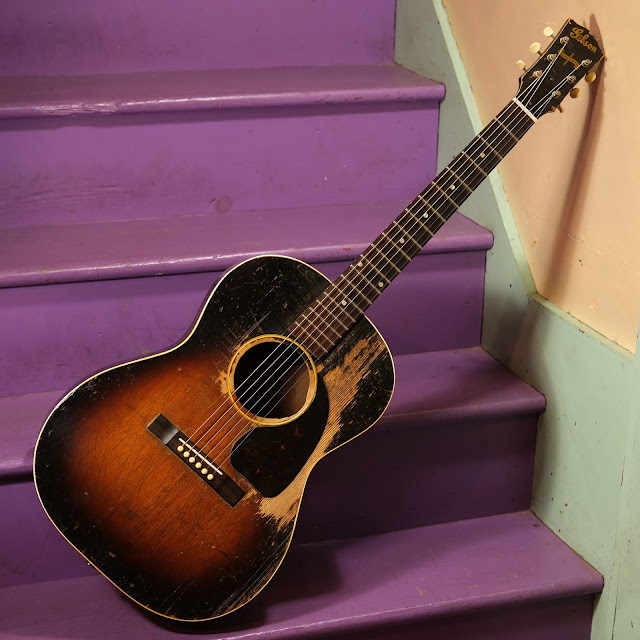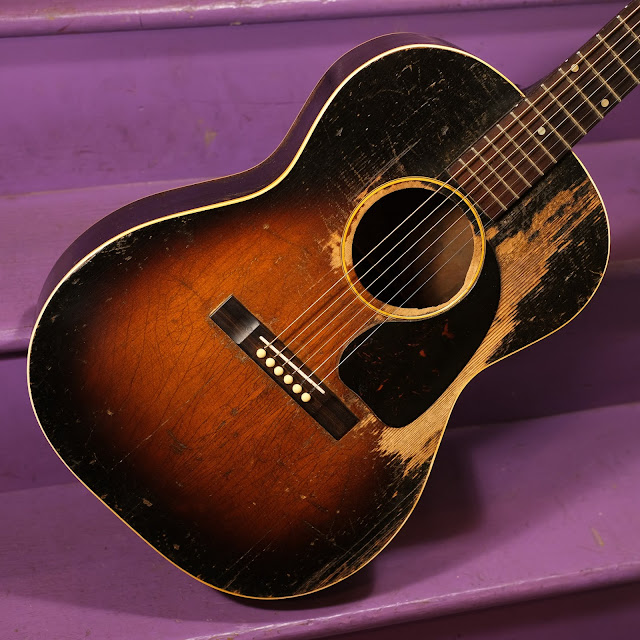1945 Gibson LG-2 Flattop Guitar
Ah, the last in our short tour of Gibson LG-2s through the years...! Click here for a recent '58 and here for a '53. This one got dropped on stage (yow) and arrived here to get fixed-up. And... it's a banner Gibson! Not only are they fashionable, but they sound great, too. You've got that mix of warmth, woodiness, and definition all rolled-up into Gibson goodness.
People often ask me what the best years of so-and-so guitars are. The wartime Gibsons are often fantastic (this one is), but I don't think that's really the answer needed. The LG-2s from this time are warmer and fuller-sounding overall, but they're also mellower on the top-end and while they sound glorious on their own, that sweetness can sometimes get covered-up when playing with a group and might be a bit too relaxed if you're trying to "dig through" other people's guitars in a jam as a fingerpicker. I always suggest mid-to-late '50s LG-2s/3s for people who need more snap.
That said, they're just about the perfect "all-around" guitar -- warm and full-enough on the bottom for a flatpicker to strum or chuck chords and responsive enough for a fingerpicker or lead-picker to really enjoy. Their EQ curve is flatter than the average Martin, too, so it's easy to hear whatever notes you're playing wherever you play them on the neck.
Repairs included: treble top/side seam repairs from the pickguard to the lower bout, top crack repairs/reinforcement of old repairs, regluing a number of back braces and top braces, a fret level/dress, cleaning, and setup. It'd previously had a refret at some point and a newer bridge and bridge plate (both good jobs) installed. I also swapped-out a Baggs M1 soundhole pickup for a K&K Pure Mini pickup.
Setup notes: the neck is straight, the truss rod works, and action is bang-on at 3/32" EA and 1/16" DGBE at the 12th fret, strung with 54w-12 gauges. The saddle is pretty low but I did give it a little extra string-ramping to keep the notes nice and clean and allow even just a hair more of adjustment if need-be.
Scale length: 24 7/8"
Nut width: 1 3/4"
String spacing at nut: 1 1/2"
String spacing at bridge: 2 1/8"
Body length: 19"
Lower bout width: 14 1/4"
Waist width: 9 3/8"
Upper bout width: 11"
Side depth at endpin: 4 3/8"
Top wood: solid spruce
Back/sides wood: solid mahogany
Neck wood: 5-piece maple w/mahogany stripes
Bracing type: x-braced
Fretboard: looks like gum, maybe? w/non-orig plastic nut
Bridge: non-orig rosewood, bone saddle, older plastic pins
Neck feel: medium-full C-shape, ~10" board radius
Condition notes: it has a ton of old repaired cracks on the top and a few on the back, the bridge is replaced, the bridge plate is replaced, and the nut and saddle are replaced. There's lots of wear and tear throughout but overall it's structurally in good order and the finish, pickguard, tuners, etc. are all-original.
Note the 5-piece maple+mahogany neck rather than mahogany -- nice and strong.














Comments